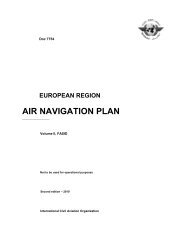7754 Vol 1 Flyleaf - ICAO Public Maps
7754 Vol 1 Flyleaf - ICAO Public Maps
7754 Vol 1 Flyleaf - ICAO Public Maps
You also want an ePaper? Increase the reach of your titles
YUMPU automatically turns print PDFs into web optimized ePapers that Google loves.
AOP III-5<br />
the operators:<br />
- apply selective taxi routes where feasible:<br />
-remove objects where feasible;<br />
-reduce size of aircraft stands where feasible;<br />
-implement reduced separation distances.<br />
Note.—Although these options may have a degrading<br />
effect on either the provision of suitable stands or on the<br />
ground movement capacity/efficiency of the aerodrome,<br />
they should however be given particular attention so as to<br />
permit B747-400 operations.<br />
37. Where the minimum separation/clearance<br />
distances as specified in Annex 14, <strong>Vol</strong>ume I, Table 3-1<br />
cannot be provided by the existing layout of an aerodrome,<br />
States may introduce lower separation standards provided<br />
that an aeronautical study indicates that such lower<br />
separation distances do not adversely affect the safety or<br />
significantly affect the regularity of operations of<br />
aeroplanes. Experience in some States with operation of<br />
B747-400 has shown that it may be permissible, if specific<br />
measures have been implemented to reduce separation<br />
distances on taxiways, apron taxiways and aircraft stand<br />
taxilanes to the dimensions specified in Attachment G to<br />
Part III — AOP of the EUR FASID.<br />
38. The provision of unambiguous and conspicuous<br />
taxi guidance to flight crews under all operational<br />
conditions prevailing at the aerodrome by appropriate<br />
means (e.g. visual aids, marshaller, etc.) is an essential<br />
prerequisite for operations conducted with lower separation<br />
distances. Equally important is the provision of good<br />
taxiway surface friction conditions at all times to ensure<br />
proper braking and nosewheel steering capability of<br />
aeroplanes.<br />
B747-400 Operations - Reduced separation distances on<br />
aircraft stand taxilanes<br />
43. On aircraft stand taxilanes, where reduced<br />
separation distances exist, proper guidance such as centre<br />
line lights or equivalent guidance (e.g. marshaller, etc.)<br />
should be provided for night, winter or low visibility<br />
operations.<br />
44. All objects not providing the minimum<br />
separation/clearance distance as specified in Annex 14,<br />
should be properly marked or lighted (Annex 14, Chapter<br />
6 refers).<br />
45. Apron service roads should be properly marked<br />
with service road boundary lines and apron safety lines<br />
(Annex 14, Chapter 5 refers).<br />
39. Regarding turns, reduced separations/clearance<br />
distances are based on the assumption that the cockpit<br />
should remain above the taxiway centre line<br />
marking/lighting as accurately as possible and at taxi speeds<br />
commensurate with actual operating conditions prevailing,<br />
except that for aircraft stand taxilanes a different technique,<br />
as specified in the AIP, may apply.<br />
B747-400 Operations - Reduced separation distances on<br />
taxiways/apron taxiways<br />
40. Whenever minimum separation distances<br />
between the centre lines of parallel taxiways or between<br />
taxiway/apron taxiway centre line and object, as specified<br />
in Annex 14, are reduced in accordance with Attachment<br />
G to Part III — AOP of the EUR FASID, taxiway centre<br />
line lighting should be provided for night, winter or low<br />
visibility operations.<br />
41. On parallel taxiways, the separation distances<br />
between the centre lines should be not less than 76 m<br />
(Attachment G to Part III — AOP of the EUR FASID<br />
refers).<br />
42. In straight portions of a taxiway or apron taxiway<br />
the separation distance between the centre line and an<br />
object such as a building or a parked aircraft should be not<br />
less than 41.5 m and in taxiway or apron taxiway curves,<br />
the separation distances between the centre line and an<br />
object should be not less than 45.5 m (Attachment G to Part<br />
III — AOP of the EUR FASID refers).<br />
46. Along straight portions of an aircraft stand<br />
taxilane, the separation distance between the centre line and<br />
an object such as a parked aircraft or a building should be<br />
not less than 40 m, whereas the wing tip clearance of an<br />
aircraft turning from a taxilane into an aircraft stand should<br />
not be less than 7.5 m as recommended in Annex 14,<br />
Chapter 3,<br />
Note.— The separation distance between the taxilane<br />
centre line and an object or edge of a service road may<br />
further be reduced to not less than 37.5 m provided that the<br />
object (e.g. blast fence) does not exceed a height of 3 m<br />
above the relative taxilane centre line.<br />
47. In curves of aircraft stand taxilanes the separation<br />
distances should not be less than 42.5 m, as specified in














